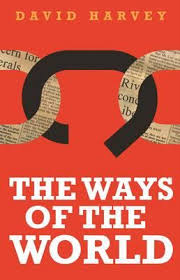Book Review: The Ways of the World by David Harvey

The Ways of the World. David Harvey. Profile Books. 2016.
The Ways of the World offers an intellectual journey through the work of David Harvey over the past five decades, compiling chapters and article excerpts from different periods in his career accompanied by retrospective commentary and insight from Harvey himself. Taken together, this collection serves as an excellent introduction to the theorist’s influential body of thought and makes a convincing call for readers to join the struggle for social justice, writes Erica Frazier.
David Harvey’s latest book, The Ways of the World, is a selection of chapter and article excerpts taken from different periods in the geographer/social theorist’s career. It is tempting to describe the book as an academic ‘greatest hits’, because it is a portfolio of an influential figure that also sparks interest in (re-)visiting his previous work. However, there are no ‘throwaway tracks’ here; instead of falling victim to the hodgepodge feeling of some musical collections, there is a strong common theme uniting each element of this book: a Marxian analysis of the systemic inequality created and reinforced through our current political economy, an interpretation that emphasises the dialogue between people and place. Through this collection, Harvey makes a convincing call for readers to join the struggle for social justice.
The book features pieces from the early 1970s on through to Harvey’s current research, and each chapter ends with a commentary from the author. These explain the context in which the bulk of the chapter was originally written, and advances the author’s current thoughts on the subject using the benefit of hindsight. This structure creates a series of nicely self-contained units. The fact that each chapter offers new or unexpected information and perspectives, but can still be read independently, makes the book feel both intellectually rewarding and reader-friendly. Readers will also be drawn in by Harvey’s compelling writing style and the book’s refreshing variety of subjects. It not only offers Harvey’s critical perspectives on political economy, urbanisation and the environment, but also an analysis of contemporary literature and the little-known history behind the construction of a famous Parisian monument.
 The book begins with some startling statistics. In recent years, China has seen an almost unimaginable construction boom. The introduction states that from 2011 to 2013, less than three years, the country used well over the amount of concrete poured in the United States throughout the entire twentieth century. Harvey explains that the Chinese economy has largely been reoriented towards debt-fuelled building projects, using this frenzy to introduce his conception of the ways that culture (including the political economy) and the environment shape one another. According to his interpretation, the Chinese government feared the over-accumulation of human capital. Having too many workers and not enough jobs produces a large population of restless people. This danger led the government to undertake construction projects of unprecedented scale, which would re-funnel labour by changing the country’s physical environment. These new surroundings would, in turn, affect the individuals who live there. This general schema conceptualising the interaction between societies and their environment reappears in each subsequent chapter, while remaining closely tied to the book’s thematic focus on exposing exploitation and injustice.
The book begins with some startling statistics. In recent years, China has seen an almost unimaginable construction boom. The introduction states that from 2011 to 2013, less than three years, the country used well over the amount of concrete poured in the United States throughout the entire twentieth century. Harvey explains that the Chinese economy has largely been reoriented towards debt-fuelled building projects, using this frenzy to introduce his conception of the ways that culture (including the political economy) and the environment shape one another. According to his interpretation, the Chinese government feared the over-accumulation of human capital. Having too many workers and not enough jobs produces a large population of restless people. This danger led the government to undertake construction projects of unprecedented scale, which would re-funnel labour by changing the country’s physical environment. These new surroundings would, in turn, affect the individuals who live there. This general schema conceptualising the interaction between societies and their environment reappears in each subsequent chapter, while remaining closely tied to the book’s thematic focus on exposing exploitation and injustice.
Chapter Four describes the famous Sacré Cœur Basilica as an attempt by the Catholic hierarchy to expiate France’s sins of secularism and immorality and to discredit the radical revolt of the Parisian Commune. Harvey later explains that, ironically, the site could also have been seen as a memorial to those who died trying to sever the State’s ties to the Church and establish socio-economic equality. Though little doubt remains as to which perspective ultimately prevailed—it is now a religious site—an engaging narrative unfolds as the chapter advances. A complicated series of events led to rebellious and conservative ‘martyrs’ alike meeting their terrestrial fates on the same hallowed heights overlooking the city. The story and its robust historical context are well complemented by contemporary illustrations, photographs and cultural anecdotes. The book demonstrates that Sacré Cœur Basilica is another excellent, and unexpected, example of a society’s exchanges with its environment. However, one of the most surprising portions of the book comes much later in Chapter Eight.
Chapter Eight advances a series of literary critiques offering a variation on the theme of cultural and environmental interaction by specifically posing the question of scale. It is also one of the most personal passages in the book. The chapter forms parallels with Welsh author Raymond Williams’s fictional works to demonstrate the difficulties and contradictions of Harvey’s own experience working with employees at a car plant in Cowley, England, in the late 1980s. It outlines their unsuccessful fight to keep the factory open as well as the way Harvey ultimately made sense of the experience. The processes of globalisation and competition were nearly impossible to counter because the resistance came from one small, local group.
However, Williams’s writing also shows how place plays an important role in shaping a society. Local movements must be constructed to provide solid foundations for the kind of wider social change that could challenge the injustices of global capitalism. Yet models for social transformation cannot be churned out through the same standardised mass production processes used for automobiles. The challenge is to achieve large-scale change that is locally powerful, or conversely, local change which can be successfully adapted to other contexts. This tension between the local and global highlights a very unevenly matched struggle which could leave readers feeling disheartened. Fortunately, Harvey does not remain content with the simple—and often much easier—role of the critic.
In addition to describing his involvement with labour unions and urban development projects, the book also offers ideas for building an effective opposition to the domination of capital and establishing a more just society. The first chapter of the book suggests ways that researchers could build new systems of social theory. Later chapters discuss the potential for new social movements and the mobilisation of marginalised urban populations. Here it is useful to mention that Harvey has also sought to promote social justice through democratising learning. He has a website featuring a series of free videos interpreting Capital by Karl Marx, which could help readers access some portions of this book.
Harvey’s latest book has a wide appeal. It would be particularly useful for those who are unacquainted or only vaguely familiar with the author’s work. The book’s breadth can be used as a starting point for readers to discover Harvey’s extended studies in the subjects most closely aligned to their own work or interests. Moreover, students and scholars from nearly any domain in the social sciences could benefit from how this collection demonstrates the ways in which Marxist theory can be applied to a range of subjects and fields. The book is an excellent introduction to Harvey’s work and personal engagements, and is also simply an enjoyable read.
Erica Frazier is a doctoral student pursuing a joint PhD in political science under the direction of Prof. John Barry at Queen’s University Belfast in Northern Ireland and Prof. Karin Fischer with the REMELICE laboratory at the Université d’Orléans, France. Her current research interests include political economy, green and labour politics and political discourses, cultures and movements in the United Kingdom and Ireland. This post first appeared on the LSE's Review of Books blog.


